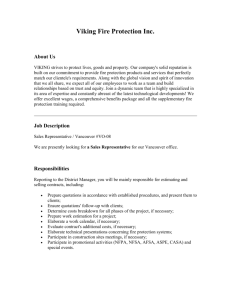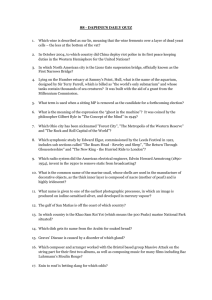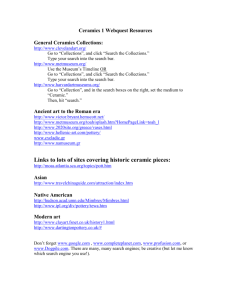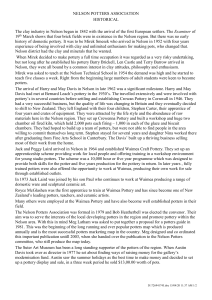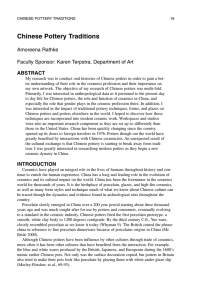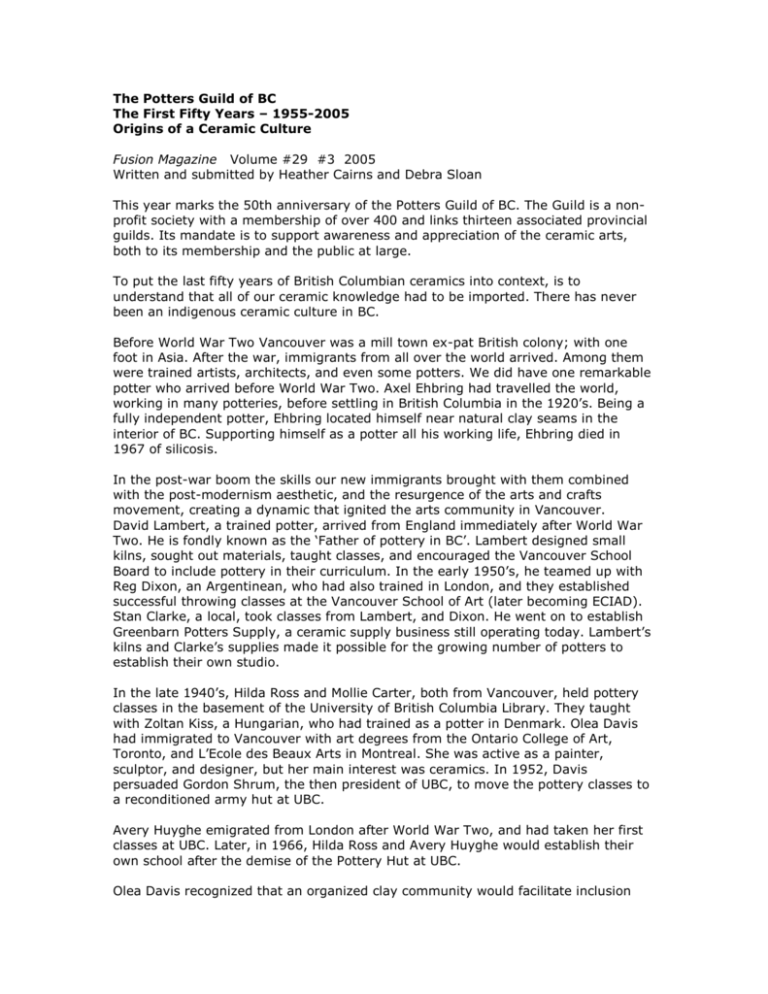
The Potters Guild of BC
The First Fifty Years – 1955-2005
Origins of a Ceramic Culture
Fusion Magazine Volume #29 #3 2005
Written and submitted by Heather Cairns and Debra Sloan
This year marks the 50th anniversary of the Potters Guild of BC. The Guild is a nonprofit society with a membership of over 400 and links thirteen associated provincial
guilds. Its mandate is to support awareness and appreciation of the ceramic arts,
both to its membership and the public at large.
To put the last fifty years of British Columbian ceramics into context, is to
understand that all of our ceramic knowledge had to be imported. There has never
been an indigenous ceramic culture in BC.
Before World War Two Vancouver was a mill town ex-pat British colony; with one
foot in Asia. After the war, immigrants from all over the world arrived. Among them
were trained artists, architects, and even some potters. We did have one remarkable
potter who arrived before World War Two. Axel Ehbring had travelled the world,
working in many potteries, before settling in British Columbia in the 1920’s. Being a
fully independent potter, Ehbring located himself near natural clay seams in the
interior of BC. Supporting himself as a potter all his working life, Ehbring died in
1967 of silicosis.
In the post-war boom the skills our new immigrants brought with them combined
with the post-modernism aesthetic, and the resurgence of the arts and crafts
movement, creating a dynamic that ignited the arts community in Vancouver.
David Lambert, a trained potter, arrived from England immediately after World War
Two. He is fondly known as the ‘Father of pottery in BC’. Lambert designed small
kilns, sought out materials, taught classes, and encouraged the Vancouver School
Board to include pottery in their curriculum. In the early 1950’s, he teamed up with
Reg Dixon, an Argentinean, who had also trained in London, and they established
successful throwing classes at the Vancouver School of Art (later becoming ECIAD).
Stan Clarke, a local, took classes from Lambert, and Dixon. He went on to establish
Greenbarn Potters Supply, a ceramic supply business still operating today. Lambert’s
kilns and Clarke’s supplies made it possible for the growing number of potters to
establish their own studio.
In the late 1940’s, Hilda Ross and Mollie Carter, both from Vancouver, held pottery
classes in the basement of the University of British Columbia Library. They taught
with Zoltan Kiss, a Hungarian, who had trained as a potter in Denmark. Olea Davis
had immigrated to Vancouver with art degrees from the Ontario College of Art,
Toronto, and L’Ecole des Beaux Arts in Montreal. She was active as a painter,
sculptor, and designer, but her main interest was ceramics. In 1952, Davis
persuaded Gordon Shrum, the then president of UBC, to move the pottery classes to
a reconditioned army hut at UBC.
Avery Huyghe emigrated from London after World War Two, and had taken her first
classes at UBC. Later, in 1966, Hilda Ross and Avery Huyghe would establish their
own school after the demise of the Pottery Hut at UBC.
Olea Davis recognized that an organized clay community would facilitate inclusion
into the larger art scene in Vancouver. By 1955, Davis, assisted by Ross, Huyghe,
and Clarke, founded the British Columbian Potters’ Guild (now, the Potters Guild of
BC). During the first decades, dozens of internationally renowned ceramists from
around the world were invited to teach in Vancouver. In true Canadian fashion, the
span of influences being delivered was, and remains today, multicultural.
Davis’ vision went beyond promoting ceramics in Vancouver and BC. She affiliated
our Guild with the Canadian Federation of Artists, the Canadian Guild of Potters, and
the American Craftsman Council. In 1964, Davis was one of three Canadians to
represent Canada at the World Craft Council.
Olea Davis encouraged Guild members to enter exhibitions at every opportunity, and
many were accorded national and international recognition. This trend continues
today. We have three Bronfman Award winners, Robin Hopper, Wayne Ngan, and
Walter Dexter. Paul Mathieu, a Chalmers Award winner, and author of “Sexpots:
Eroticism in Ceramics”, * is presently an Associate Professor of Ceramics at the Emily
Carr Institute of Art and Design. Tam Irving, who was associated with the ceramics
program at ECIAD for over 25 years, is represented in the ceramic collection at the
Victoria and Albert Museum .
Since 1985, the Guild has operated the Gallery of BC Ceramics, located at 1359
Cartwright Street, Vancouver, on Granville Island. Representing the work of over 100
of its members, this venue offers the broadest selection of functional pottery and
ceramic sculpture in the province. It also features rotating solo and small group
exhibits.
‘BC in a Box’, is a travelling exhibition of 150 exquisite pottery miniatures. This
show challenged our members to create on a small scale while remaining true to
their aesthetic. It allows the PGBC to celebrate its members’ work in a variety of
communities throughout the province.
From August 9 – September 11, ‘TransFormations’ will be exhibited at the Burnaby
Art Gallery. This show will feature a juried exhibition of contemporary work as well as
an historical component documenting our history and the evolution of BC Ceramics.
Another 50th anniversary initiative is a collaborative venture with potters from Tajimi,
Japan. In August, our members exhibited fifty juried works alongside 50 works by
Tajimi potters during the prestigious 7th Mino International Exhibition. In 2006, the
BC-Tajimi exhibition will travel to Vancouver.
The Potters Guild of BC was not founded on the European model, where an
association fixed standards and prices, and protected and controlled its members.
Olea Davis had very particular reasons for founding the Guild – to learn, to make, to
participate, and to use the strength of a collective for ceramics to be seen and
noticed. Adhering to this historical practice, we remain a diverse, supportive,
interactive and unconstrained community - a reflection of our cultural makeup and of
our physical setting.
* “SEXPOTS: Eroticism in Ceramics”, 2003, A&C Black, London (UK), Rutgers
University Press (USA), Haupt (Germany].
Copyright Heather Cairns and Debra Sloan 2005. All Rights Reserved.





